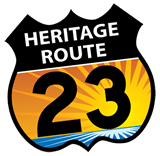Coastal fen is a sedge- and rush-dominated lacustrine wetland that occurs on calcareous substrates along Lake Huron and Lake Michigan north of the climatic tension zone. The community occurs on marl and organic soils in historic coastal embayments and on moderately alkaline, carbonate-rich fine-textured sands and clays lakeward. Vegetation is comprised primarily of calciphilic species capable of growing on wet alkaline substrates. Fluctuating Great Lakes water levels at multiple spatial and temporal scales and groundwater seepage are the primary natural processes that influence community structure, species composition, and succession. - Michigan Natural Features Inventory
Flowers include:
Aster borealis (rush aster), Campanula aparinoides (marsh bellflower), Decodon verticillatus (whorled loosestrife), Euthamia graminifolia (grass-leaved goldenrod), Iris versicolor (wild blue flag), Lobelia kalmii (Kalm’s lobelia), Lycopus uniflorus (northern bugleweed), Lysimachia terrestris (swamp candles), Menyanthes trifoliata (bog buckbean), Parnassia glauca (grass-of-Parnassus), Potentilla anserine (silverweed), P. palustris (marsh cinquefoil), Scheuchzeria palustris (arrow-grass), Solidago ohioensis (Ohio goldenrod), S. uliginosa (bog goldenrod), Tofieldia glutinosa (false asphodel), Triadenum fraseri (marsh St. John’s-wort), and Triglochin maritimum (common bog arrow-grass).
Things To Do
Plant Community Viewing, Plant Viewing
![]()
![]()
![]()



